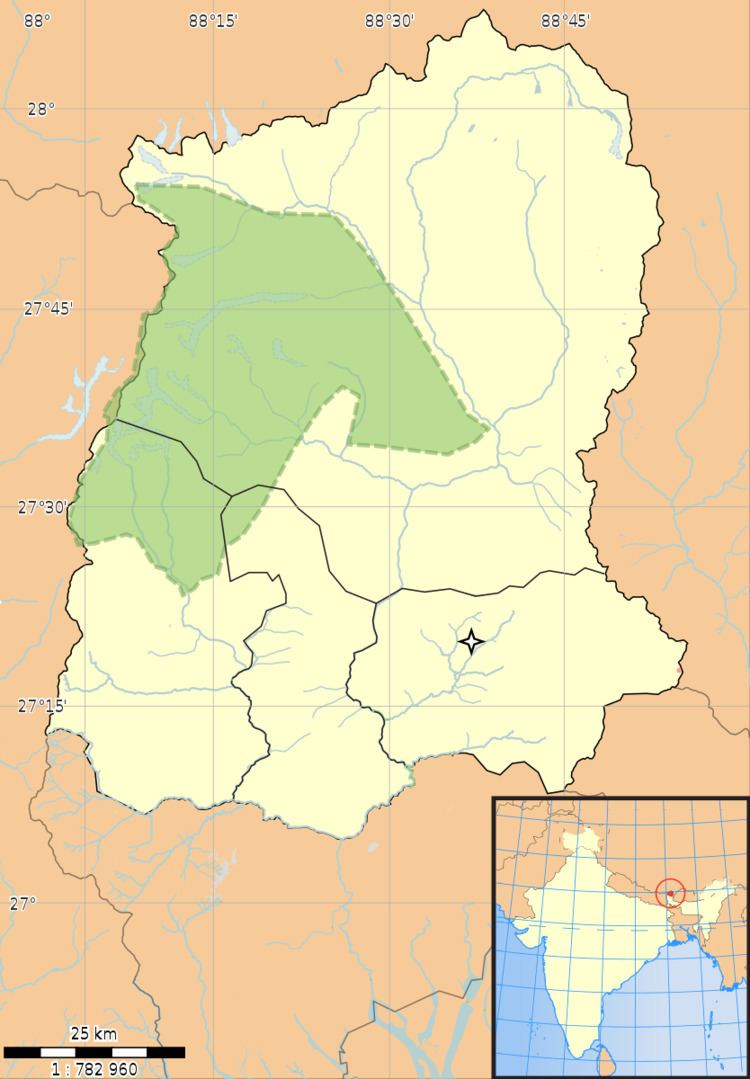Visitors NA (in NA) Criteria iii, vi, vii, x Area 1,784 km² | Type Mixed Address Sikkim 737116 Established 1977 | |
 | ||
Hours Open today · Open 24 hoursHoli might affect these hoursMonday(Holi)Open 24 hoursHours might differTuesdayOpen 24 hoursWednesdayOpen 24 hoursThursdayOpen 24 hoursFridayOpen 24 hoursSaturdayOpen 24 hoursSundayClosed Similar Dzongri, Mountain Tours - Tre and Trav, Pemyang Monastery, Singalila National Park, Rumtek Dharma Chakra C | ||
Khangchendzonga national park sikkim india
Khangchendzonga National Park (previously named Kanchenjunga National Park) also Kanchenjunga Biosphere Reserve is a National Park and a Biosphere reserve located in Sikkim, India. It was inscribed to the UNESCO World Heritage Sites list on July 17, 2016, becoming the first "Mixed Heritage" site of India. The park gets its name from the mountain Kanchenjunga (alternative spelling Khangchendzonga) which is 8,586 metres (28,169 ft) tall, the third-highest peak in the world. The total area of this park is 849.5 km2 (328.0 sq mi).
Contents
- Khangchendzonga national park sikkim india
- Khangchendzonga national park on unseco world heritage list
- Human history
- Geography
- Flora
- Fauna
- Avifauna
- Trekking
- Lodging
- Approach
- General Information
- References
There are many glaciers in the park including the Zemu glacier. Animals like musk deer, snow leopard, Clouded Leopard, and Himalayan tahr all make their home in this park.
Khangchendzonga national park on unseco world heritage list
Human history
There are a few Lepcha tribal settlements inside the park.
Geography
The Kanchenjunga Park is situated in the North and West Sikkim districts in the Indian state of Sikkim. It has an elevation of 1,829 metres (6,001 ft) to over 8,550 metres (28,050 ft) and has an area of 849.50 km2 (327.99 sq mi). It is one of the few high altitude National parks of India. Recently, it is included in UNESCO's World Heritage sites.
In the north it adjoins the Qomolangma National Nature Preserve in Tibet, and in the east the Kanchenjunga Conservation Area in Nepal.
Flora
The vegetation of the park include temperate broadleaf and mixed forests consisting of oaks, fir, birch, maple, willow etc. The vegetation of the park also includes alpine grasses and shrubs at higher altitudes along with many medicinal plants and herbs.
Fauna
The park contains many mammal species including musk deer, snow leopard, Himalayan tahr, wild dog, sloth bear, civet, Himalayan black bear, red panda, Tibetan wild ass, Himalayan blue sheep, serow, goral and takin, as well as reptiles including rat snake and Russell's viper.
A recent study revealed, that the Asiatic wild dog has become very rare in the area. The wild dogs in the Khangchendzonga Biosphere Reserve are believed to belong to the rare and genetically distinct subspecies C. a. primaevus.
Avifauna
About 550 species of birds are found inside the park including blood pheasant, satyr tragopan, osprey, Himalayan griffon, lammergeier, Tragopan pheasant, green pigeon, Tibetan snowcock, snow pigeon, impeyan pheasant, Asian emerald cuckoo, sunbird and eagle. A new species of bird named Himalayan Forest Thrush has been found in 2016. It's scientific name is Zoothera Salimalii.
Trekking
Most of the trekking routes starts from Yuksom (145 km (90 mi) from Gangtok) in West Sikkim. Necessary Permit can be obtained from the Wildlife Education and Interpretation center at Yuksom or from the check post. State Tourism Department along with other travel agents organize treks to Dzongri (4,050 metres (13,290 ft)) and other places. The popular trek routes are:
Another popular trekking point includes trekking to the Green Lake with Lachen, a village in North Sikkim as the starting point. Foreign nationals would require a restricted area permit from the Ministry of Home Affairs, Government of India, Delhi to visit the park and the associated region. Indian nationals are required to obtain an Inner-Line Permit from the State Home Department. Permission of the State Chief Wildlife Warden is also mandatory for everybody visiting the park. The important and popular routes are:
Most of these trekking routes pass through the Kanchenjunga National Park.
Lodging
Lodging can be done at the Range office where there are four rest houses with about 20 beds.
Approach
General Information
The best season to visit the Kanchenjunga national park is between April to May. Snowfall is heavy during the winter months and monsoon showers occur from May to mid October.
Foreign nationals would require a restricted area permit from the Ministry of Home Affairs, Government of India, Delhi to visit the park and the associated region. Indian nationals are required to obtain an Inner-Line Permit from the State Home Department. Permission of the State Chief Wildlife Warden is also mandatory for everybody visiting the park.
